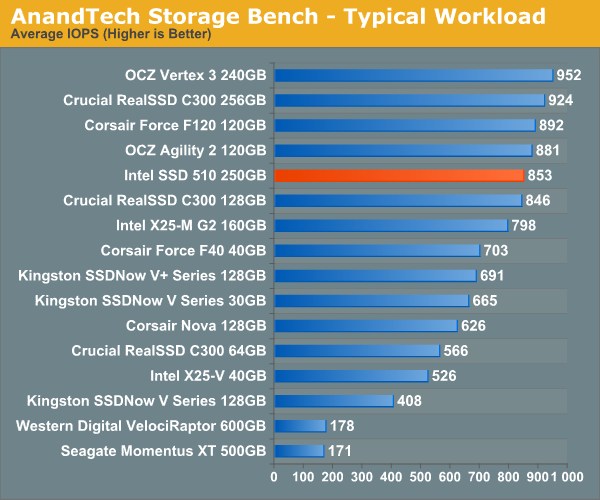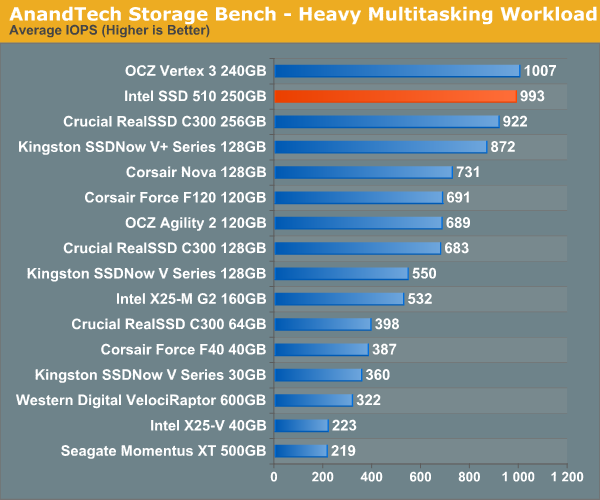The Intel SSD 510 Review
by Anand Lal Shimpi on March 2, 2011 1:23 AM EST- Posted in
- IT Computing
- Storage
- SSDs
- Intel
- Intel SSD 510
AnandTech Storage Bench 2010
To keep things consistent we've also included our older Storage Bench. Note that the old storage test system doesn't have a SATA 6Gbps controller, so we only have one result for the 6Gbps drives.
The first in our benchmark suite is a light/typical usage case. The Windows 7 system is loaded with Firefox, Office 2007 and Adobe Reader among other applications. With Firefox we browse web pages like Facebook, AnandTech, Digg and other sites. Outlook is also running and we use it to check emails, create and send a message with a PDF attachment. Adobe Reader is used to view some PDFs. Excel 2007 is used to create a spreadsheet, graphs and save the document. The same goes for Word 2007. We open and step through a presentation in PowerPoint 2007 received as an email attachment before saving it to the desktop. Finally we watch a bit of a Firefly episode in Windows Media Player 11.
There’s some level of multitasking going on here but it’s not unreasonable by any means. Generally the application tasks proceed linearly, with the exception of things like web browsing which may happen in between one of the other tasks.
The recording is played back on all of our drives here today. Remember that we’re isolating disk performance, all we’re doing is playing back every single disk access that happened in that ~5 minute period of usage. The light workload is composed of 37,501 reads and 20,268 writes. Over 30% of the IOs are 4KB, 11% are 16KB, 22% are 32KB and approximately 13% are 64KB in size. Less than 30% of the operations are absolutely sequential in nature. Average queue depth is 6.09 IOs.
The performance results are reported in average I/O Operations per Second (IOPS):

If there’s a light usage case there’s bound to be a heavy one. In this test we have Microsoft Security Essentials running in the background with real time virus scanning enabled. We also perform a quick scan in the middle of the test. Firefox, Outlook, Excel, Word and Powerpoint are all used the same as they were in the light test. We add Photoshop CS4 to the mix, opening a bunch of 12MP images, editing them, then saving them as highly compressed JPGs for web publishing. Windows 7’s picture viewer is used to view a bunch of pictures on the hard drive. We use 7-zip to create and extract .7z archives. Downloading is also prominently featured in our heavy test; we download large files from the Internet during portions of the benchmark, as well as use uTorrent to grab a couple of torrents. Some of the applications in use are installed during the benchmark, Windows updates are also installed. Towards the end of the test we launch World of Warcraft, play for a few minutes, then delete the folder. This test also takes into account all of the disk accesses that happen while the OS is booting.
The benchmark is 22 minutes long and it consists of 128,895 read operations and 72,411 write operations. Roughly 44% of all IOs were sequential. Approximately 30% of all accesses were 4KB in size, 12% were 16KB in size, 14% were 32KB and 20% were 64KB. Average queue depth was 3.59.

The gaming workload is made up of 75,206 read operations and only 4,592 write operations. Only 20% of the accesses are 4KB in size, nearly 40% are 64KB and 20% are 32KB. A whopping 69% of the IOs are sequential, meaning this is predominantly a sequential read benchmark. The average queue depth is 7.76 IOs.











128 Comments
View All Comments
lyeoh - Wednesday, March 2, 2011 - link
Oh yeah, thanks for the max latency figures. They're very useful.The G2's max of 900ms is quite a long time. Nearly a second! What are the max latencies for say a velociraptor in similar tests? I know the theoretical figures would be based on seek time + RPM but often theory is different from practice.
I find it interesting that the Crucial RealSSD C300 does worse than the Intel SSD 510 in the "Anand Storage Bench 2011- Heavy Workload" despite getting better numbers in the random and sequential tests. Any idea why this would be so? Poorer max latency?
jimhsu - Wednesday, March 2, 2011 - link
Poorer sequential performance I guess. The C300 (which I just got) is very fast, but the sequential perf of the 510 is simply better, which impacts a lot of the sequential portion of the workload test. Random performance in typical desktop models has reached somewhat of a plateau, particularly since most applications currently out there are optimized for the dog-slow random performance of consumer hard drives.Creepwood - Friday, March 4, 2011 - link
About reliability/compatibility: have you tested this drive in the new Sandy Bridge Macbook Pro? Any issues?davepermen - Monday, March 7, 2011 - link
Interestingly, one of THE main performance cases is when you need to quickly write lots of stuff, like in video editing. And there, all data is at least partially compressed, so i guess there the intel will be in a better place.RaistlinZ - Wednesday, March 2, 2011 - link
Intel is going to have to price this thing cheaper than the Vertex 3, or any other new Sandforce SSD for that matter. They can't use performance as a selling point. I'm sure the new SF controller will offer good stability. Unless you're an Intel fanboy I don't see any reason to get the 510 over the Vertex 3, unless they price it much lower.semo - Wednesday, March 2, 2011 - link
This is an Atom alright!I think the conclusion, although critical in places was overall mild. “It looks like we may have hit the upper limit of what we need from 4KB random write performance”… Yeah, in the consumer/budget space. But what consumer/budget computer user would buy a 250GB SSD. I’ve managed to convince a few of my clients to go with an “expensive upgrade” and in the end they’ve been extremely happy… In those cases I’ve only installed 64GB drives.
At the moment SSDs are NOT mainstream and it’s mostly the enthusiast and pro crowd that will be buying consumer grade SSDs. I’ll be using my SSD for VMs for testing and studying and I do a lot of heavy random IO operations.
For a drive as big and as expensive as the 250GB 510, I expect much better across-the-board performance.
TSnor - Wednesday, March 2, 2011 - link
Hi, the article states "~900ms write operation, the 510 keeps the worst case latency to below 400ms. The Vertex 3 by comparison has a max write latency of anywhere from 60ms - 350ms"microseconds are usually abbreviated us, where the u has a funny tail on it. (the u is greek for something)
ms usually means milliseconds. I usually type 'mics' when on the keyboard and reserve the funny u for when handwriting. example, a good SSD write takes less then 100 mics.
saying something is around 900 ms means it takes about a second.
epicsnackus - Wednesday, March 2, 2011 - link
The article is correct, the numbers are really in milliseconds. The microsecond numbers you're thinking of are 1) best case, and 2) usually readsChloiber - Wednesday, March 2, 2011 - link
"Write speed with fully incompressible data is easily a victory for the SF-2200 based OCZ Vertex 3."I think you meant fully compressible?
Anand Lal Shimpi - Wednesday, March 2, 2011 - link
Fixed! Thank you :)Take care,
Anand